- Home
- Edgar Allan Poe
The Science Fiction of Edgar Allan Poe (Penguin Classics) Page 29
The Science Fiction of Edgar Allan Poe (Penguin Classics) Read online
Page 29
A very slight inspection of the Heavens assures us that the stars have a certain general uniformity, equability, or equidistance, of distribution through that region of space in which, collectively, and in a roughly globular form, they are situated : – this species of very general, rather than absolute, equability, being in full keeping with my deduction of inequidistance, within certain limits, among the originally diffused atoms, as a corollary from the design of infinite complexity of relation out of irrelation. I started, it will be remembered, with the idea of a generally uniform but particularly ununiform distribution of the atoms; – an idea, I repeat, which an inspection of the stars, as they exist, confirms.
But even in the merely general equability of distribution, as regards the atoms, there appears a difficulty which, no doubt, has already suggested itself to those among my readers who have borne in mind that I suppose this equability of distribution effected through radiation from a centre. The very first glance at the idea, radiation, forces us to the entertainment of the hitherto unseparated and seemingly inseparable idea of agglomeration about a centre, with dispersion as we recede from it – the idea, in a word, of inequability of distribution in respect to the matter radiated.
Now, I have elsewhere* observed26 that it is by just such difficulties as the one now in question – such peculiarities – such roughness – such protuberances above the plane of the ordinary – that Reason feels her way, if at all, in her search for the True. By the difficulty – the ‘peculiarity’ – now presented, I leap at once to the secret – a secret which I might never have attained but for the peculiarity and the inferences which, in its mere character of peculiarity, it affords me.
The process of thought, at this point, may be thus roughly sketched : – I say to myself – ‘Unity, as I have explained it, is a truth – I feel it. Diffusion is a truth – I see it. Radiation, by which alone these two truths are reconciled, is a consequent truth – I perceive it. Equability of diffusion, first deduced à priori and then corroborated by the inspection of phænomena, is also a truth – I fully admit it. So far all is clear around me : – there are no clouds behind which the secret – the great secret of the gravitating modus operandi-can possibly lie hidden;-but this secret lies hereabouts, most assuredly; and were there but a cloud in view, I should be driven to suspicion of that cloud.’ And now, just as I say this, there actually comes a cloud into view. This cloud is the seeming impossibility of reconciling my truth, radiation, with my truth, equability of diffusion. I say now: – ‘Behind this seeming impossibility is to be found what I desire.’ I do not say ‘real impossibility’, for invincible faith in my truths assures me that it is a mere difficulty after all – but I go on to say, with unflinching confidence, that, when this difficulty shall be solved, we shall find, wrapped up in the process of solution, the key to the secret at which we aim. Moreover – I feel that we shall discover but one possible solution of the difficulty; this for the reason that, were there two, one would be supererogatory – would be fruitless – would be empty – would contain no key – since no duplicate key can be needed to any secret of Nature.
And now, let us see : – Our usual notions of radiation – in fact all our distinct notions of it – are caught merely from the process as we see it exemplified in Light. Here there is a continuous outpouring of ray-streams, and with a force which we have at least no right to suppose varies at all. Now, in any such radiation as this – continuous and of unvarying force – the regions nearer the centre must inevitably be always more crowded with the radiated matter than the regions more remote. But I have assumed no such radiation as this. I assumed no continuous radiation; and for the simple reason that such an assumption would have involved, first, the necessity of entertaining a conception which I have shown no man can entertain, and which (as I will more fully explain hereafter) all observation of the firmament refutes – the conception of the absolute infinity of the Universe of Stars – and would have involved, secondly, the impossibility of understanding a rëaction – that is, gravitation – as existing now – since, while an act is continued, no rëaction, of course, can take place. My assumption, then – or rather my inevitable deduction from just premises – was that of a determinate radiation – one finally discontinued.
Let me now describe the sole possible mode in which it is conceivable that matter could have been diffused through space, so as to fulfil the conditions at once of radiation and of generally equable distribution.
For convenience of illustration, let us imagine, in the first place, a hollow sphere of glass, or of anything else, occupying the space throughout which the universal matter is to be thus equally diffused, by means of radiation, from the absolute, irrelative, unconditional Particle, placed in the centre of the sphere.
Now, a certain exertion of the diffusive power (presumed to be the Divine Volition) – in other words, a certain force – whose measure is the quantity of matter – that is to say, the number of atoms – emitted; emits, by radiation, this certain number of atoms; forcing them in all directions outwardly from the centre – their proximity to each other diminishing as they proceed – until, finally, they are distributed, loosely, over the interior surface of the sphere.
When these atoms have attained this position, or while proceeding to attain it, a second and inferior exercise of the same force – or a second and inferior force of the same character – emits, in the same manner – that is to say, by radiation as before – a second stratum of atoms which proceeds to deposit itself upon the first; the number of atoms, in this case as in the former, being of course the measure of the force which emitted them; in other words the force being precisely adapted to the purpose it effects – the force and the number of atoms sent out by the force, being directly proportional.
When this second stratum has reached its destined position – or while approaching it – a third still inferior exertion of the force, or a third inferior force of a similar character – the number of atoms emitted being in all cases the measure of the force – proceeds to deposit a third stratum upon the second: – and so on, until these concentric strata, growing gradually less and less, come down at length to the central point; and the diffusive matter, simultaneously with the diffusive force, is exhausted.
We have now the sphere filled, through means of radiation, with atoms equably diffused. The two necessary conditions – those of radiation and of equable diffusion – are satisfied; and by the sole process in which the possibility of their simultaneous satisfaction is conceivable.* For this reason, I confidently expect to find, lurking in the present condition of the atoms as distributed throughout the sphere, the secret of which I am in search – the all-important principle of the modus operandi of the Newtonian law. Let us examine, then, the actual condition of the atoms.
They lie in a series of concentric strata. They are equably diffused throughout the sphere.
The atoms being equably distributed, the greater the superficial extent of any of these concentric strata, or spheres, the more atoms will lie upon it. In other words, the number of atoms lying upon the surface of any one of the concentric spheres, is directly proportional with the extent of that surface.
But, in any series of concentric spheres, the surfaces are directly proportional with the squares of the distances from the centre.†
Therefore the number of atoms in any stratum is directly proportional with the square of that stratum’s distance from the centre.
But the number of atoms in any stratum is the measure of the force which emitted that stratum – that is to say, is directly proportional with the force.
Therefore the force which radiated any stratum is directly proportional with the square of that stratum’s distance from the centre : – or, generally,
The force of the radiation has been directly proportional with the squares of the distances: – or, particularly, The force by which any individual atom was sent to its position in the sphere, was directly proportional with the square of that atom’s dist
ance while in that position, from the centre of the sphere.
Now, Rëaction, as far as we know any thing of it, is Action conversed. The general principle of Gravity being, in the first place, understood as the rëaction of an act – as the expression of a desire on the part of Matter, while existing in a state of diffusion, to return into the Unity whence it was diffused; and, in the second place, the mind being called on to determine the character of the desire – the manner in which it would, naturally, be manifested; in other words, being called on to conceive a probable law, or modus operandi, for the return; could not well help arriving at the conclusion that this law of return would be precisely the converse of the law of departure. That such would be the case, any one, at least, would be abundantly justified in taking for granted, until such time as some person should suggest something like a plausible reason why it should not be the case – until such a period as a law of return shall be imagined which the intellect can consider as preferable.
Matter, then, radiated into space with a force varying as the squares of the distances, might, à priori, be supposed to return towards its centre of radiation with a force varying inversely as the squares of the distances: and I have already shown * that any principle which will explain why the atoms should tend, according to any law, to the general centre, must be admitted as satisfactorily explaining, at the same time, why, according to the same law, they should tend each to each. For, in fact, the tendency to the general centre is not to a centre as such, but because of its being a point in tending towards which each atom tends most directly to its real and essential centre, Unity – the absolute and final Union of all.
The consideration here involved presents to my own mind no embarrassment whatever – but this fact does not blind me to the possibility of its being obscure to those who may have been less in the habit of dealing with abstractions: – and, on the whole, it may be as well to look at the matter from one or two other points of view.
The absolute, irrelative particle primarily created by the Volition of God, must have been in a condition of positive normality, or rightfulness – for wrongfulness implies relation. Right is positive; wrong is negative – is merely the negation of right; as cold is the negation of heat – darkness of light. That a thing may be wrong, it is necessary that there be some other thing in relation to which it is wrong – some condition which it fails to satisfy; some law which it violates; some being whom it aggrieves. If there be no such being, law, or condition, in respect to which the thing is wrong – and, still more especially, if no beings, laws, or conditions exist at all – then the thing cannot be wrong and consequently must be right.
Any deviation from normality involves a tendency to return to it. A difference from the normal – from the right – from the just – can be understood as effected only by the overcoming a difficulty; and if the force which overcomes the difficulty be not infinitely continued, the ineradicable tendency to return will at length be permitted to act for its own satisfaction. On withdrawal of the force, the tendency acts. This is the principle of reaction as the inevitable consequence of finite action. Employing a phraseology of which the seeming affectation will be pardoned for its expressiveness, we may say that Rëaction is the return from the condition of as it is and ought not to be into the condition of as it was, originally, and therefore ought to be: – and let me add here that the absolute force of Rëaction would no doubt be always found in direct proportion with the reality – the truth – the absoluteness – of the originality – if ever it were possible to measure this latter: – and, consequently, the greatest of all conceivable rëactions must be that manifested in the tendency which we now discuss – the tendency to return into the absolutely original – into the supremely primitive. Gravity, then, must be the strongest of forces – an idea reached à priori and abundantly confirmed by induction. What use I make of the idea, will be seen in the sequel.
The atoms, now, having been diffused from their normal condition of Unity, seek to return to — what? Not to any particular point, certainly; for it is clear that if, on the diffusion, the whole Universe of matter had been projected, collectively, to a distance from the point of radiation, the atomic tendency to the general centre of the sphere would not have been disturbed in the least: – the atoms would not have sought the point in absolute space from which they were originally impelled. It is merely the condition, and not the point or locality at which this condition took its rise, that these atoms seek to re-establish; – it is merely that condition which is their normality, that they desire. ‘But they seek a centre,’ it will be said, ‘and a centre is a point.’ True; but they seek this point not in its character of point – (for, were the whole sphere moved from its position, they would seek, equally, the centre; and the centre then would be a new point) – but because it so happens, on account of the form in which they collectively exist – (that of the sphere) – that only through the point in question – the sphere’s centre – they can attain their true object, Unity. In the direction of the centre each atom perceives more atoms than in any other direction. Each atom is impelled towards the centre because along the straight line joining it and the centre and passing on to the surface beyond, there lie a greater number of atoms than along any other straight line joining it, the atom, with any point of the sphere – a greater number of objects that seek it, the individual atom – a greater number of tendencies to Unity – a greater number of satisfactions for its own tendency to Unity – in a word, because in the direction of the centre lies the utmost possibility of satisfaction, generally, for its own individual appetite. To be brief, the condition, Unity, is all that is really sought; and if the atoms seem to seek the centre of the sphere, it is only impliedly – through implication – because such centre happens to imply, to include, or to involve, the only essential centre, Unity. But on account of this implication or involution, there is no possibility of practically separating the tendency to Unity in the abstract, from the tendency to the concrete centre. Thus the tendency of the atoms to the general centre is, to all practical intents and for all logical purposes, the tendency each to each; and the tendency each to each is the tendency to the centre; and the one tendency may be assumed as the other; whatever will apply to the one must be thoroughly applicable to the other; and, in conclusion, whatever principle will satisfactorily explain the one, cannot be questioned as an explanation of the other.
In looking carefully around me for rational objection to what I have advanced, I am able to discover nothing; – but of that class of objections usually urged by the doubters for Doubt’s sake, I very readily perceive three; and proceed to dispose of them in order.
It may be said, first: ‘The proof that the force of radiation (in the case described) is directly proportional with the squares of the distances, depends on an unwarranted assumption – that of the number of atoms in each stratum being the measure of the force with which they are emitted.’
I reply, not only that I am warranted in such assumption, but that I should be utterly unwarranted in any other. What I assume is, simply, that an effect is the measure of its cause – that every exercise of the Divine Will will be proportional with that which demands the exertion – that the means of Omnipotence, or of Omniscience, will be exactly adapted to its purposes. Neither can a deficiency nor an excess of cause bring to pass any effect. Had the force which radiated any stratum to its position, been either more or less than was needed for the purpose – that is to say, not directly proportional with the purpose – then to its position that stratum could not have been radiated. Had the force which, with a view to general equability of distribution, emitted the proper number of atoms for each stratum, been not directly proportional with the number, then the number would not have been the number demanded for the equable distribution.
The second supposable objection is somewhat better entitled to an answer.
It is an admitted principle in Dynamics that every body, on receiving an impulse, or disposition to move, will mov
e onward in a straight line, in the direction imparted by the impelling force, until deflected, or stopped, by some other force. How then, it may be asked, is my first or external stratum of atoms to be understood as discontinuing their movement at the surface of the imaginary glass sphere, when no second force, of more than an imaginary character, appears, to account for the discontinuance?
I reply that the objection, in this case, actually does arise out of ‘an unwarranted assumption’ – on the part of the objector – the assumption of a principle, in Dynamics, at an epoch when no ‘principles’, in anything, exist:28 – I use the word ‘principle’, of course, in the objector’s understanding of the word.
‘In the beginning’ we can admit – indeed we can comprehend – but one First Cause – the truly ultimate Principle – the Volition of God. The primary act – that of Radiation from Unity – must have been independent of all that which the world now calls ‘principle’ – because all that we so designate is but a consequence of the rëaction of that primary act: – I say ‘primary’ act; for the creation of the absolute material Particle is more properly to be regarded as a conception than as an ‘act’ in the ordinary meaning of the term. Thus, we must regard the primary act as an act for the establishment of what we now call ‘principles’. But this primary act itself is to be considered as continuous Volition. The Thought of God is to be understood as originating the Diffusion – as proceeding with it – as regulating it – and, finally, as being withdrawn from it on its completion. Then commences Rëaction, and through Rëaction, ‘Principle’, as we employ the word. It will be advisable, however, to limit the application of this word to the two immediate results of the discontinuance of the Divine Volition – that is, to the two agents, Attraction and Repulsion. Every other Natural agent depends, either more or less immediately, on these two, and therefore would be more conveniently designated as sub-principle.

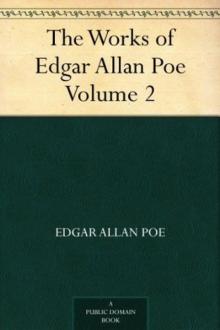 The Works of Edgar Allan Poe — Volume 2
The Works of Edgar Allan Poe — Volume 2 The Works of Edgar Allan Poe — Volume 1
The Works of Edgar Allan Poe — Volume 1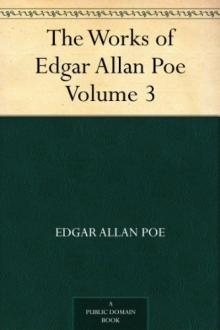 The Works of Edgar Allan Poe — Volume 3
The Works of Edgar Allan Poe — Volume 3 The Works of Edgar Allan Poe — Volume 5
The Works of Edgar Allan Poe — Volume 5 The Works of Edgar Allan Poe — Volume 4
The Works of Edgar Allan Poe — Volume 4 The Tell-Tale Heart
The Tell-Tale Heart The Raven (Penguin)
The Raven (Penguin) The Paris Mysteries
The Paris Mysteries Tales of Terror from Edgar Allan Poe
Tales of Terror from Edgar Allan Poe The Fall of the House of Usher
The Fall of the House of Usher The Golden Book of World's Greatest Mysteries
The Golden Book of World's Greatest Mysteries The Narrative of Arthur Gordon Pym of Nantucket
The Narrative of Arthur Gordon Pym of Nantucket Ligeia
Ligeia The Landscape Garden
The Landscape Garden Complete Tales & Poems
Complete Tales & Poems Great Tales and Poems of Edgar Allan Poe
Great Tales and Poems of Edgar Allan Poe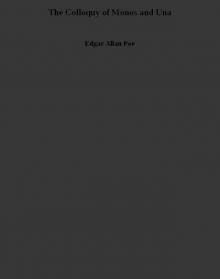 The Colloquy of Monos and Una
The Colloquy of Monos and Una The Oblong Box
The Oblong Box Thou Art the Man
Thou Art the Man A DESCENT INTO THE MAELSTROM
A DESCENT INTO THE MAELSTROM THE MURDERS IN THE RUE MORGUE
THE MURDERS IN THE RUE MORGUE The Business Man
The Business Man The Mystery of Marie Rogêt
The Mystery of Marie Rogêt Metzengerstein
Metzengerstein The Man That Was Used Up
The Man That Was Used Up William Wilson
William Wilson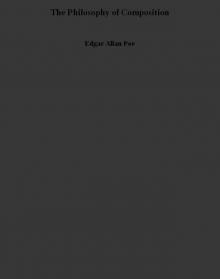 The Philosophy of Composition
The Philosophy of Composition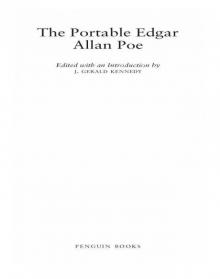 The Portable Edgar Allan Poe
The Portable Edgar Allan Poe Bon-Bon
Bon-Bon A Predicament
A Predicament The Premature Burial
The Premature Burial The Angel of the Odd
The Angel of the Odd The Man of the Crowd
The Man of the Crowd Never Bet the Devil Your Head
Never Bet the Devil Your Head The Tell-Tale Heart and Other Writings
The Tell-Tale Heart and Other Writings The System of Doctor Tarr and Professor Fether
The System of Doctor Tarr and Professor Fether Selected Tales (Oxford World's Classics)
Selected Tales (Oxford World's Classics) Essential Tales and Poems of Edgar Allan Poe (Barnes & Noble Classics Series)
Essential Tales and Poems of Edgar Allan Poe (Barnes & Noble Classics Series) MS. Found in a Bottle
MS. Found in a Bottle Some Words with a Mummy
Some Words with a Mummy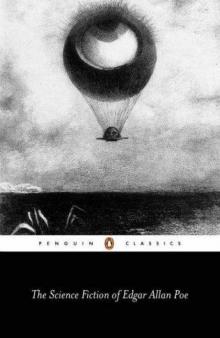 The Science Fiction of Edgar Allan Poe (Penguin Classics)
The Science Fiction of Edgar Allan Poe (Penguin Classics) King Pest
King Pest CRITICISM
CRITICISM How to Write a Blackwood Article
How to Write a Blackwood Article Mystification
Mystification Diddling Considered as One of the Exact Sciences
Diddling Considered as One of the Exact Sciences Steampunk Poe
Steampunk Poe The Literary Life of Thingum Bob, Esq.
The Literary Life of Thingum Bob, Esq. Classic Crime Collection
Classic Crime Collection Complete Stories and Poems of Edgar Allen Poe
Complete Stories and Poems of Edgar Allen Poe Berenice
Berenice The Black Cat
The Black Cat The Slender Poe Anthology
The Slender Poe Anthology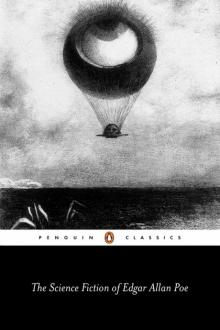 The Science Fiction of Edgar Allan Poe
The Science Fiction of Edgar Allan Poe The Assignation
The Assignation The Thousand-and-Second Tale of Scheherazade
The Thousand-and-Second Tale of Scheherazade The Raven and Other Short Stories
The Raven and Other Short Stories The Spectacles
The Spectacles Hop-Frog
Hop-Frog The Purloined Letter
The Purloined Letter Mellonta Tauta
Mellonta Tauta The Balloon-Hoax
The Balloon-Hoax Landor's Cottage
Landor's Cottage Mesmeric Revelation
Mesmeric Revelation The Pit and the Pendulum
The Pit and the Pendulum